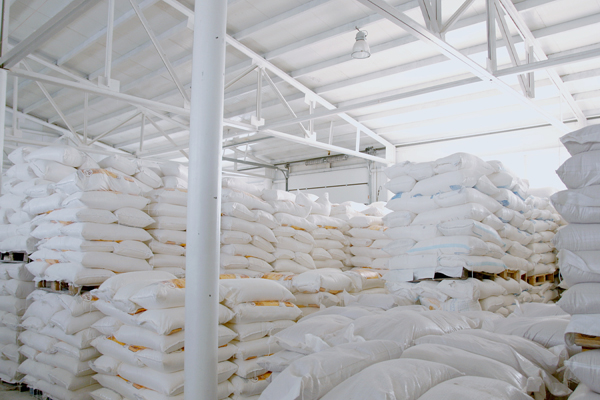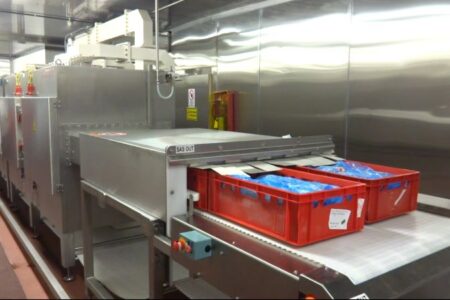When the dust settles

The food processing industries account for approximately 24 per cent of total recorded dust explosions in the UK (HFL Risk Services). The source ingredients of some of our tastiest snacks can be catalysts for destructive explosions. These could be ignited by one small ember and rapidly fuelled by an organic dust cloud.
The range of explosive dusts is very expansive across many sectors and encompasses organic materials that most people would not even consider to be an explosive risk. The Occupational Health & Safety Administration (OSHA) has compiled a comprehensive list of combustible dusts that pose an explosion risk during processing. In the food industry, that includes seemingly innocuous raw materials like tomatoes, egg white and onion – all are listed as potentially combustive materials when they are being processed in powdered form.
Explosion incidents
Perhaps the most well known food explosion risk is that of grain flours. Flour mills have been an explosion risk for decades, fuelled by the dusty atmospheres they create. There have been newsworthy examples of grain mill fires around Europe in recent years: Verdelot in France saw the destruction of Moulins Bourgeois mill in 2010; and a major fire broke out in Chancelot Mill in Edinburgh in 2014. In 2015, the trend continued as fire consumed Allied Mills at Tilbury Docks, London.
The originating causes of grain mill fires can be varied – a spark, a carelessly discarded match, electrical fault or grinding and milling friction. Grain mills are therefore a high explosion risk sector.
Sugar dust has been responsible for several explosion incidents around the world. One of the most notable examples, commonly cited as a cautionary tale, is the Imperial Sugar Plant explosion of 2008 in the US. Significant accumulations of sugar dust in the factory were ignited, probably by a very small spark. However, the ensuing secondary explosions and fire claimed 14 lives and left nearly 40 people with serious burn injuries.
The British Sugar refinery in Cantley (Norfolk) also suffered a series of devastating explosions in 2003. They propagated throughout the facility causing severe damage starting in the bucket elevators and through dust extraction systems. The more alarming fact about this incident is that the factory was not operational and hadn’t been for some time. The ignition of the sugar dust was caused by welding repairs on the exterior of a bucket elevator. It was a total surprise as to how fast and vigorous the explosion propagation was from the moment of ignition by the welder’s spark.
Even the processing of milk powder has risks. The spray drying of milk turns this harmless, everyday beverage into a potentially destructive explosive force when manufacturing milk powder. There have been notably destructive incidents around the world involving milk powder production. In 2006 a man was killed in a dust borne explosion at a milk powder production facility in Gorinchem, Holland. The Visalia milk powder processing plant in California experienced an explosion that tore a hole through the side of the facility in 2008. And in 2012, a devastating explosion caused nearly AU$300,000 worth of damage when a powdered milk facility succumbed to an explosive inferno.
The risks are real, and they destroy businesses and take lives. So how do you reduce them?
Protective measures
Understanding the nature of your dust
Different types of dust have different particle sizes, properties, ignition temperatures and ignition sources respectively. Dusts are given explosion severity classifications: St1 to St3. ‘Not specified’ means the material is non explosive and St3 is the most explosive type of material. Sugar and cocoa powder are rated at St1, like flour and paper which are well known explosive dusts.
Dust testing identifies two key performance characteristics of dust, which in turn influence explosion protection equipment design and their application. The first measures maximum pressure of a dust explosion (Pmax in bar), while the second identifies the speed of the rise in explosive pressure (KSt in m/sec).
Because of their varying explosive properties, organic dust producing materials are often handled and stored in different ways and locations. Therefore, the protective measures in each location will be tailored to meet the associated risk.
Good housekeeping
An explosion risk can be caused by the build up of deposits of combustible dust which may accumulate on surfaces in the processing facility.
In the UK, for example, the Health and Safety Executive (HSE) recommends that as well as a rigorous cleaning regime, there should be total elimination of dust from high level horizontal surfaces, eg by use of sloping surfaces to minimise dust accumulation.
Spark detection
In the case of milk powder production, self ignition in the dryers is the most prevalent start to an explosive incident. Spark detection devices sense hot particles right at the outset of a possible ignition incident; they could easily become the source for a fire or explosion.
Spark detection systems can incorporate automated shutdown functions to interrupt the feed of combustible material along the process equipment. These processes can be monitored by an operative via a control panel and who can assess any further risks.
By preventing sparks, embers and hot particles from reaching dust rich downstream process equipment, such as dust collectors, bins and silos, both fire and explosion risks can be managed.
Chemical suppression
Advanced chemical suppression systems are designed to detect the start of an explosion (point of ignition) and deliver dry, inert chemical extinguishing agents into a developing internal deflagration. These suppression and isolation systems can be activated by pressure, optical or vent sensors.
A possible deflagration travelling through ducts, piping and connected equipment is quickly and efficiently extinguished, thereby preventing any spreading explosion damage.
Flameless venting
If an explosion does occur inside a process or storage vessel containing combustible materials, a rapid rise in pressure can result, putting staff and equipment at risk. Explosion vents are the preferred passive method to relieve such explosive pressure.
The most advanced flameless vents intercept, quench and retain all burning materials, preventing them from expelling into the atmosphere. They are particularly useful for dust collectors, bins and bucket elevators.
Explosions vents are designed to burst at a predetermined activation pressure and open instantly at the start of an explosion. Flames are quenched through stainless steel mesh that absorbs and dissipates heat and pressure.
A process shutdown can also be activated to limit the intake of additional fuel to other process areas.
Isolation
Explosion isolation is designed to prevent any kind of deflagration or explosion from spreading to other parts of the process equipment. Where chemical suppression is used to reduce the initial building pressure in an enclosure, some hot gasses will attempt to exit to areas of lower pressure. This causes a flow through the inlets and outlets of the enclosure.
It is not always necessary to isolate all the enclosure inlets and outlets, but any exceptions are assessed on an individual basis.
There are two methods of isolation:
- Passive isolation: does not require detectors or control and indicating equipment. These may be arrestor mesh, rotary valves, lock valves, rotary screws, flap valves or diversion valves
- Active isolation: activated by detectors and a control and indicating equipment. These detectors could then operate pinch valves, chemical isolation or fast acting valves.
Explosion protection
The most useful course of action is to seek the guidance of recognised experts in explosion propagation and mitigation. At BS&B we always offer or recommend a survey of a facility, followed by laboratory dust testing. All our explosion protection solutions cover the key risks. The important part is finding out how to apply them to your factory to achieve the best safety conditions for your staff and the facility in which they work.
The accidents that have caused so much damage give us a valuable glimpse of what mistakes to avoid. Knowledge is power and the key that can save lives and livelihoods.



